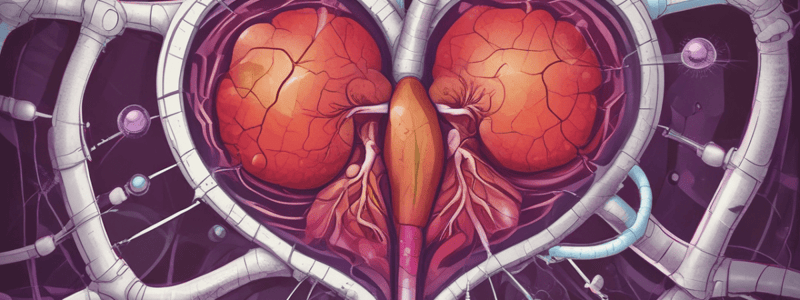Podcast
Questions and Answers
What is the primary function of the liver in relation to orally absorbed metabolites?
What is the primary function of the liver in relation to orally absorbed metabolites?
- To store metabolites
- To excrete metabolites
- To generate toxic metabolites
- To metabolize many orally absorbed metabolites (correct)
What type of hepatotoxicity occurs when a compound inhibits transport pumps in sinusoidal or canalicular membranes?
What type of hepatotoxicity occurs when a compound inhibits transport pumps in sinusoidal or canalicular membranes?
- Cholestatic injury (correct)
- Idiosyncratic toxicity
- Cytotoxic injury
- Dose-dependent hepatotoxicity
What is the mechanism of dose-dependent hepatotoxicity induced by acetaminophen?
What is the mechanism of dose-dependent hepatotoxicity induced by acetaminophen?
- Transporter dysfunction
- P450 induction
- Mitochondrial dysfunction
- Oxidative stress (correct)
Which drug is known to cause idiosyncratic toxicity?
Which drug is known to cause idiosyncratic toxicity?
What is the safe dose of acetaminophen in dogs as an anti-pyretic or pain reliever?
What is the safe dose of acetaminophen in dogs as an anti-pyretic or pain reliever?
What is the consequence of acetaminophen overdose in cats?
What is the consequence of acetaminophen overdose in cats?
What is the enzyme that glucuronidates acetaminophen in humans?
What is the enzyme that glucuronidates acetaminophen in humans?
What is the treatment for acetaminophen overdose?
What is the treatment for acetaminophen overdose?
What are the poor prognostic indicators of acute liver failure?
What are the poor prognostic indicators of acute liver failure?
What is the effective treatment for xylitol intoxication?
What is the effective treatment for xylitol intoxication?
What type of fungi contain amatoxins?
What type of fungi contain amatoxins?
What is the mechanism of action of amatoxins?
What is the mechanism of action of amatoxins?
What is the effect of silybin on amatoxin uptake?
What is the effect of silybin on amatoxin uptake?
What type of organism causes blue-green algae toxicity?
What type of organism causes blue-green algae toxicity?
What is the effect of microcystin and nodularin on the liver?
What is the effect of microcystin and nodularin on the liver?
What is the toxic principle of Cycad Palms?
What is the toxic principle of Cycad Palms?
What is the mortality rate of cycad toxicosis?
What is the mortality rate of cycad toxicosis?
What is the treatment for blue-green algae toxicity?
What is the treatment for blue-green algae toxicity?
What is the primary mechanism of toxicity associated with azole antifungals?
What is the primary mechanism of toxicity associated with azole antifungals?
Which drug is associated with a 45% incidence of clinically significant hepatotoxicosis in dogs?
Which drug is associated with a 45% incidence of clinically significant hepatotoxicosis in dogs?
What is the primary mechanism of toxicity associated with potentiated sulfonamides?
What is the primary mechanism of toxicity associated with potentiated sulfonamides?
What is the effect of fluconazole on liver enzymes compared to other azole antifungals?
What is the effect of fluconazole on liver enzymes compared to other azole antifungals?
What is the primary mechanism of toxicity associated with azathioprine?
What is the primary mechanism of toxicity associated with azathioprine?
What is the effect of SAMe on CCNU hepatopathy?
What is the effect of SAMe on CCNU hepatopathy?
What is the primary mechanism of toxicity associated with tetracyclines?
What is the primary mechanism of toxicity associated with tetracyclines?
Which breed of dog is overrepresented in idiosyncratic sulfonamide toxicosis?
Which breed of dog is overrepresented in idiosyncratic sulfonamide toxicosis?
What is the effect of carprofen on liver enzymes?
What is the effect of carprofen on liver enzymes?
What is the effect of methimazole on liver enzymes in hyperthyroid cats?
What is the effect of methimazole on liver enzymes in hyperthyroid cats?
Flashcards are hidden until you start studying
Study Notes
Toxic Hepatic Disease
- Liver is the site of first-pass metabolism of many orally absorbed metabolites, some of which can generate toxic metabolites.
- Two types of hepatotoxicities:
- Cytotoxic injury leading to hepatocellular pattern of liver enzyme elevation due to hepatocyte necrosis.
- Cholestatic injury occurs when a compound inhibits transport pumps in sinusoidal or canalicular membranes, leading to interference with bile salt efflux and hepatocyte function.
Dose-Dependent Hepatotoxicity
- Mechanisms of dose-dependent hepatotoxicity:
- Oxidative stress: acetaminophen, azathioprine, azole antifungals.
- Mitochondrial dysfunction: tetracyclines, amiodarone.
- P450 induction: phenytoin, phenobarbital.
- Transporter dysfunction: endotoxin.
- Examples of dose-dependent hepatotoxicity:
- Acetaminophen:
- Safe in dogs as an anti-pyretic or pain reliever at 10-15 mg/kg PO q8 hr.
- Doses > 150-250 mg/kg can lead to acute centrilobular necrosis in dogs.
- In cats, hematologic toxicosis with methemoglobinemia and cyanosis occurs over liver toxicity.
- Phenobarbital:
- Toxicity occurs with cumulative dose and after years of treatment.
- Bridging portal fibrosis, bile duct hyperplasia, nodular regeneration.
- Azole antifungals:
- Can lead to mild, clinically insignificant increases in ALT.
- Toxicity may be associated with toxic metabolite N-deacetyl ketoconazole, which leads to glutathione depletion.
- Azathioprine:
- Increases in ALT and bilirubin in 20% of dogs.
- Mechanism is due to generation of oxidative metabolites and depletion of glutathione.
- Amiodarone:
- Clinically significant heptotoxicosis in 45% of dogs at a median of 16 weeks.
- Clinically significant increases in ALT and occasional hyperbilirubinemia.
- Lomustine (CCNU):
- Alkylating agent used for single-agent chemo in dogs with mast cell tumors, lymphoma, and histiocytic sarcoma.
- 30% of dogs will have a substantial increase in ALT.
- Tetracyclines:
- 36-39% of dogs showed an increase in ALT or ALP into the abnormal range during treatment.
- Toxicity may be due to inhibition of beta-oxidation of fatty acids in hepatic mitochondria.
- Acetaminophen:
Idiosyncratic Hepatotoxicity
- Examples of idiosyncratic hepatotoxicity:
- Potentiated sulfonamides:
- Hepatic necrosis is the common histologic lesion.
- Clinical signs occur at a mean of 12 days after initiation of therapy.
- Carprofen:
- 1.4 cases per 10,000 dogs treated.
- Acute hepatic failure 5 to 30 days after drug initiation with bridging hepatic fibrosis.
- Methimazole:
- 1-2% of hyperthyroid cats treated with methimazole develop hepatocellular or cholestatic liver enzyme pattern and visible jaundice.
- Diazepam:
- Idiosyncratic reaction in cats.
- Dramatic increases in ALT with marked centrilobular hepatic necrosis.
- Potentiated sulfonamides:
Household and Environmental Toxins
- Examples of household and environmental toxins:
- Alfatoxin:
- Produced by Aspergillus species and can be found in moldy corn or soy.
- Activated by cytochrome P450 enzymes to metabolites that lead to protein and DNA adducts and glutathione depletion.
- Xylitol:
- When ingested by dogs at dosages of 0.15 g/kg or higher, xylitol leads to acute intoxication characterized by insulin release and clinical signs of hypoglycemia within 30 to 60 minutes.
- Acute hepatic necrosis can occur 6 to 72 hours after exposure.
- Amanita:
- Contain amatoxins, which inhibit RNA polymerases, leading to decreased mRNA generation, arrested protein synthesis, and necrosis of metabolically active cells.
- Vomiting, bloody diarrhea, and abdominal pain occur within 6 to 24 hours of ingestion.
- Blue-green algae:
- Proliferate in warm, stagnant, nutrient-rich waters.
- The cyanotoxins microcystin and nodularin inhibit serine/threonine protein phosphatases in the liver, with subsequent hyperphosphorylation and disruption of cytoskeletal proteins.
- Cycad palms:
- The toxic principle, cycasin, is bioactivated to methylazoxymethanol by gut bacteria, leading to gastrointestinal and hepatic toxicosis.
- GI signs can develop within minutes to hours of ingestion, while biochemical signs of hyperbilirubinemia and increases in hepatocellular and cholestatic enzyme activities may not develop for 24 to 48 hours.
- Alfatoxin:
Studying That Suits You
Use AI to generate personalized quizzes and flashcards to suit your learning preferences.



